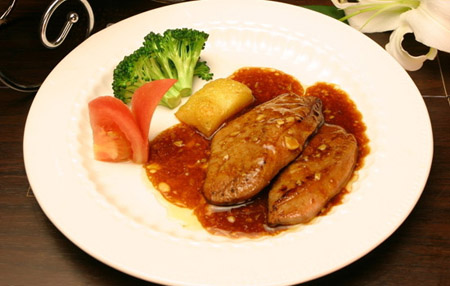
Foie gras, a controversial jewel in the French culinary crown, is one of a few delicacies many people love to hate.
Foie gras, or fat liver, is the greatly enlarged liver of a goose or duck fattened by force-feeding, usually with a tube two or three times a day.
Foie gras is praised for its creamy and smooth texture as well as buttery liver flavor, but its production is criticized as barbaric by many animal rights groups that seek to ban the product.
Criticism hasn't slowed producers and foie gras remains popular worldwide, including in China and Japan where there is no foie gras tradition.
The period from October to March is usually the prime foie gras season due to high European production.
Chefs integrate the foie gras into their own culinary style, creating diverse flavors and textures.
"Avoid too much preparation overpowering the natural flavor, avoid overcooking to preserve the mild texture and highlight a pleasant sweet-and-salty flavor. That's the classical French way with foie gras," says Frenchman Christophe Truchet, sous chef at Jade on 36 in Pudong Shangri-La, East Shanghai.
Foie gras may be hot or cold. Traditional low-heat cooking results in terrines, pates and mousses that highlight the flavor. Hot-pan cooking sears the liver to highlight the texture, crispy outside and creamy inside.
Both liver and eel are pan-fried and topped with duck sauce. It's served with black cherry compote to add sweetness. Fragrant lime and rose petals are sprinkled on top. The dish balances sweet and salty flavors; eel and foie gras have similar textures.
Foie gras is pan-seared in the French way, but with a modern touch of raw oysters and seaweed in a bit of Japanese Dashi soup. The taste is balanced and the liver cannot be overpowered.
The outside of the foie gras, sprinkled with lemon jam, is crispy, sweet-and-sour, which contrasts with the succulent inside. Savory Dashi soup adds more flavors to the buttery liver.
Raw egg is combined with a mixture of pureed foie gras, sea crab and carrot, and then steamed and served hot.
Chef Masami achieves balanced flavor with layers, starting with the sweet and umami crab, followed by delicate egg flavor and then a rich aftertaste of fatty foie gras.
It's also used to make dessert and foie gras creme brulee is classic.
Some Chinese chefs prepare foie gras with traditional Chinese techniques.
Chef Du Caiqing at Hyatt on the Bund marinates foie gras in Shaoxing wine with snow peas. Wine cuts the fattiness of the liver while crispy peas add textural contrast to the smoothy foie gras.
